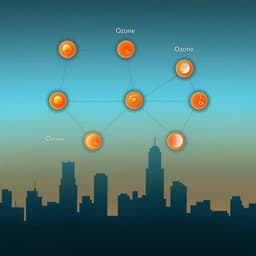
Economics
Job loss and health threatening events modulate risk-taking behaviours in the Covid-19 emergency
C. Galandra, C. Cerami, et al.
This study reveals interesting contrasts in risk-taking behavior among healthcare and non-healthcare workers during the Covid-19 lockdown, offering insights into economic implications and behavioral changes. Conducted by Caterina Galandra, Chiara Cerami, Gaia Chiara Santi, Alessandra Dodich, Stefano F. Cappa, Tomaso Vecchi, and Chiara Crespi, the research uncovers how the pandemic shaped our approach to risk in health and employment contexts.
~3 min • Beginner • English
Introduction
The Covid-19 pandemic rapidly triggered a global health emergency and an unprecedented social and economic crisis. Italy, especially the Northern regions, faced strict lockdown measures from March to May 2020, with widespread reorganization of healthcare services and massive disruption to employment. The study investigates whether first-person exposure to the pandemic's health threats and economic repercussions modulates individual risk-taking attitudes. The authors developed the Covid-19 Risk Task (Cov19-RT), extending the classical monetary Holt-Laury task with two ecological domains: health status and employment status outcomes directly related to Covid-19. Research aims: (1) describe risk-taking profiles of Italian residents during lockdown, comparing monetary to ecological health and employment conditions; (2) test incentive effects (changes in risk preferences with higher payoffs) in each condition; (3) compare healthcare vs non-healthcare workers given their differing employment stability during lockdown. Hypotheses: individuals would be more risk-averse in the monetary condition than in health and employment conditions; healthcare workers would be less risk-averse for employment-related outcomes than non-healthcare workers.
Literature Review
Prior research on catastrophic events shows mixed effects on risk preferences. Some studies report increased risk aversion following life-threatening experiences (e.g., tsunami survivors; post-election violence in Kenya), consistent with preferring sure outcomes to avoid negative emotions associated with losses. Other studies find increased risk-loving behaviour among exposed individuals (e.g., Hurricane Katrina evacuees; civil-war exposure in Burundi), preferring more uncertain options with equal or higher expected value. Most previous studies used monetary risk tasks and collected data after the event, potentially missing domain-specific and real-time effects. The present study addresses these gaps by using ecological, Covid-19-related outcomes and collecting data during the emergency.
Methodology
Design and power: A priori power analysis (G*Power) indicated 128 participants to detect Wilcoxon signed-rank effects with dz=0.3 at 0.95 power (alpha=0.05). Participants and sampling: From the PsyCOVID study cohort, adults of working age (25–65 years) who were employed were invited. Exclusions: <25 or >65 years, unemployed, students, housewives, retired. Invitations were sent to 280 matched participants (140 healthcare workers; 140 non-healthcare workers) matched by age, education, gender, and geographic area. Data collection occurred online via Google Forms between April 3–23, 2020. Final sample: 130 participants (65 healthcare workers: 83.1% female; mean age 38.43±10.37; education 17.51±1.11 years; 65 non-healthcare workers: 53.8% female; mean age 38.46±8.18; education 17.11±1.70). Response rate: 46%. Task: The Covid-19 Risk Task (Cov19-RT) included three conditions, each with two series (Series 1: lower payoffs; Series 2: higher payoffs), each series comprising 10 paired lotteries (Lottery A: safer; Lottery B: riskier) with probabilities increasing from 10% to 100% for the higher outcome across rows. Conditions: - Monetary Condition (MC): Series 1 Lottery A: 200€ vs 160€; Lottery B: 385€ vs 10€. Series 2 Lottery A: 4000€ vs 3200€; Lottery B: 7700€ vs 200€. - Health Status Condition (HsC): Ecological health outcomes anchored to perceived severity (e.g., symptomatic Covid-19 without hospitalization vs Type II Diabetes for Lottery A; shoulder fracture vs symptomatic Covid-19 with hospitalization for Lottery B in Series 1; Series 2 included psoriasis, asymptomatic Covid-19, common cold, symptomatic Covid-19 without hospitalization). - Employment Status Condition (EsC): Ecological employment outcomes anchored to perceived hardship (e.g., paid leave with 2/3 salary reduction vs work from home with 50% salary reduction for Lottery A; 30 days paid leave vs unpaid furlough for Lottery B in Series 1; Series 2 included 15 days paid leave, part-time work, work from home with full salary, paid leave with 2/3 salary reduction). All stimuli were hypothetical to avoid confounding real vs hypothetical incentives across domains. Content validity: Two 24-item lists (health and employment outcomes) were evaluated by 38 healthy individuals (balanced by age and gender) for clarity and severity/hardship on 5-point Likert scales. Unclear items were removed; items were ordered by perceived severity. Ecological lotteries were calibrated to mirror the CRRA mapping of the monetary condition (less severe outcomes paired with higher monetary equivalents). Measures: Number of safe choices (Lottery A) per series: MC1, MC2, HsC1, HsC2, EsC1, EsC2; overall mean per condition: mMC, mHsC, mEsC. Risk profile classification followed CRRA-based cutoffs: risk-loving (0–3 safe choices), risk-neutral (4), mildly risk-averse (5–6), highly risk-averse (7–10). Statistical analysis: Non-parametric tests using SPSS/JASP with alpha=0.05. - Associations among conditions: Spearman correlations among mMC, mHsC, mEsC. - Within-condition incentive effects: Wilcoxon signed-rank tests comparing Series 1 vs Series 2 for each condition in whole sample and by group. - Across-condition differences: Friedman test with Wilcoxon post hoc on mMC, mHsC, mEsC. - Between-group differences: Mann–Whitney U tests (healthcare vs non-healthcare) for each series and mean measures; effect sizes reported as rank-biserial correlations.
Key Findings
Sample demographics: 130 participants (68.5% female), mean age 38.5±9.3 years; groups matched on age, education, geography; sex distribution differed (healthcare workers more often female). Risk profile distributions: - Monetary condition (mean across series): highly risk-averse 50.8%, mildly risk-averse 32.2%, risk-neutral 8.5%, risk-loving 8.5%. - Health status condition: risk-loving 51.5%, risk-neutral 14.6%, mildly risk-averse 24.6%, highly risk-averse 9.3%. - Employment status condition: mildly risk-averse 48.5%, highly risk-averse 27.7%, risk-neutral 10.0%, risk-loving 13.8%. Associations between conditions: - mHsC and mEsC were significantly related (Spearman r = −0.231, p < 0.008). - No significant association between mMC and either ecological condition (mHsC vs mMC: r = 0.47, p = 0.592; mEsC vs mMC: r = 0.49, p = 0.578). Across-condition differences: - Friedman test indicated significant differences across conditions (χ² = 76.177, p < 0.0001). - Post hoc Wilcoxon tests: participants were more risk-averse in MC than HsC (z = −7.919, p < 0.0001, r = 0.895) and than EsC (z = −3.002, p < 0.003, r = 0.344); EsC showed more risk-averse choices than HsC (z = −5.872, p < 0.0001, r = −0.663). Incentive effects (Series 1 vs Series 2): - Whole sample: MC showed a shift toward more risk aversion with higher payoffs (z = −3.343, p = 0.001, r = −0.532). HsC and EsC showed reversed effects with shifts toward more risk-loving behaviour as payoffs increased (HsC: z = −7.880, p < 0.001, r = 0.905; EsC: z = −8.585, p < 0.001, r = 0.921). - By group: Both healthcare and non-healthcare workers showed the reversed incentive effect in HsC (healthcare: z = −5.477, p < 0.001, r = 0.907; non-healthcare: z = −5.666, p < 0.001, r = 0.898) and EsC (healthcare: z = −6.042, p < 0.001, r = 0.910; non-healthcare: z = −6.139, p < 0.001, r = 0.932). Only non-healthcare workers showed a significant incentive effect in MC (z = −3.699, p < 0.001, r = −0.830). Between-group differences (healthcare vs non-healthcare): - Employment condition: healthcare workers were less risk-averse (EsC1: U = 1562, p < 0.0001, r = 0.261; EsC2: U = 1704, p = 0.040, r = 0.193; mEsC: U = 1517.5, p = 0.003, r = 0.282). - No significant group differences in MC (MC1: U = 1880, p = 0.242; MC2: U = 2022.5, p = 0.626; mMC: U = 2080.5, p = 0.870) or HsC (HsC1: U = 1943, p = 0.401; HsC2: U = 1993.5, p = 0.434; mHsC: U = 1795, p = 0.108).
Discussion
Findings support domain-specific modulation of risk-taking during the Covid-19 emergency. Participants were significantly more risk-averse for monetary outcomes than for health- and employment-related outcomes, and risk-taking patterns in the two ecological conditions were inversely related, suggesting individuals prioritized the domain perceived as more salient (health vs employment) during the crisis. The classic incentive effect replicated for monetary lotteries, with higher stakes increasing risk aversion. In contrast, in the ecological conditions higher stakes produced greater risk-taking, likely because the outcomes were personally salient and tied to real-life health and employment status, motivating attempts to achieve the most favourable state or avoid looming threats. Group comparisons showed healthcare workers were less risk-averse than non-healthcare workers in employment-related decisions, consistent with their relative job stability during lockdown, whereas no group differences emerged for monetary or health domains. Overall, the study demonstrates that risk preferences measured with conventional monetary tasks may not generalize to real-life domains during a catastrophe; ecological, context-specific stimuli captured distinct and stronger shifts in behaviour.
Conclusion
The study introduces an ecological extension of the Holt-Laury task to assess risk-taking in health and employment domains during the Covid-19 pandemic. Italian adults during lockdown were more risk-averse in monetary decisions than in Covid-19-related health and employment decisions. Higher payoffs increased monetary risk aversion but led to more risk-taking in ecological domains. Healthcare workers were less risk-averse than non-healthcare workers for employment outcomes, reflecting differential job security. These results highlight the importance of domain- and context-specific assessments of risk during large-scale crises. Future research should employ longitudinal designs, larger and more diverse samples, include geographic exposure measures, and compare hypothetical vs incentivized ecological outcomes to refine understanding of how catastrophic events reshape risk attitudes across domains.
Limitations
Cross-sectional design prevents causal inference on changes over time. Small-to-moderate sample with unequal sex distribution between groups limits generalizability. Lack of detailed control for geographic origin and local epidemic severity constrains interpretation of regional exposure effects. All payoffs were hypothetical (including monetary), which may differ from real-incentive settings. Response rate was moderate (46%).
Related Publications
Explore these studies to deepen your understanding of the subject.







